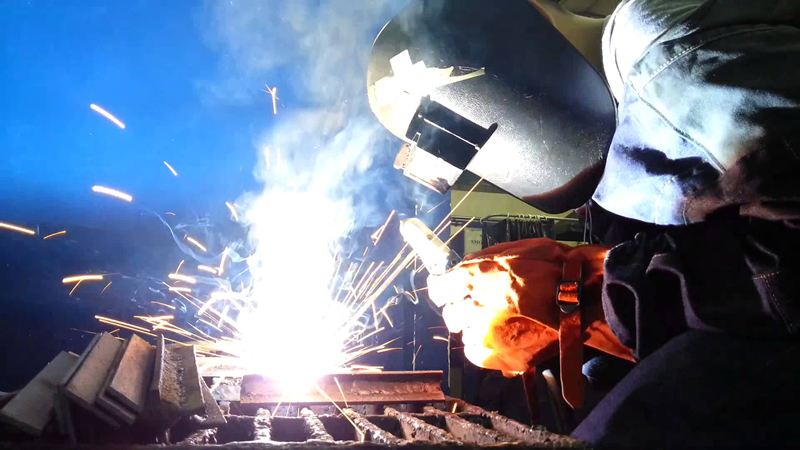Advantages of welding inverters
Technical:
- high efficiency – 85-95%;
- ideal power factor – 0.99;
- minimum consumption of scarce electrical materials;
- wide range of regulation of mode parameters – from several amperes to hundreds and thousands;
The welding inverter has a much wider welding current adjustment range than a conventional machine, which is especially important when welding with thin electrodes:
- 1.6 or 2 mm in diameter. The arc at low currents “whispers”, there is no splashing – not welding, but pure pleasure;
- load duration of power sources in the operating range of welding modes – up to 80%;
- the possibility of parallel operation of sources for a single load;
- smooth adjustment of the welding mode in a wide range of currents and voltages;
- source remote control;
- minimal losses of electrical energy in welding cables and connecting elements;
- small dimensions and weight, ease of carrying and delivering the source to the welding site;
- high level of electrical safety due to double insulation.
Technological:
- welding with coated electrodes of any brands on direct and alternating current;
- versatility of the external static characteristic, which provides manual arc welding with a coated electrode, non-consumable – in an argon environment, mechanized with a consumable electrode in shielding gases;
- arc ignition stability due to high Uxx and oscillation;
- the possibility of welding with a short arc, which reduces energy losses and improves the quality of the welded joint due to the reduction of the heat-affected zone;
- high-quality seam formation in all spatial positions;
- minimum spatter during welding;
- the ability to exclude magnetic blast when welding with direct current;
- welding of hard-to-weld steels and alloys;
- microprocessor control of the welding inverter provides a stable feedback of the current and voltage on the arc with the output parameters of the machine.
When the arc is ignited, the device generates an additional current pulse (the so-called “hot start”), and in the event of a short circuit, the welding current is immediately turned off – that is, it is almost impossible to “freeze” the electrode here;
the possibility of welding complex metal structures by welders of low qualification.
Disadvantages of welding inverters
The cost of an inverter welding machine is about 2-3 times higher than a welding transformer. That is, if the welder’s experience is high enough or a special quality of work is not required, then when buying a welding machine, you can get by with less money.
Traditional welding machines are usually cheaper to repair. When they fail, the “heart” of the inverter – the I.G.B.T. – you will have to pay from 1/3 to half the cost of the device itself. Breakage occurs in cases of sudden overload: the welder tries to cut very thick and strong metal (for example, a rail) as quickly as possible, as well as during large power surges in the mains. In such cases, the protection of the device – a thermal relay – simply does not have time to work.
The inverter is more afraid of dust than other welding machines. This is especially true for manufacturing and construction. The inverter must be cleaned and purged much more often than other types of welding machines.
Electronics “does not like” temperatures below zero degrees. And operation at – 150C and below can “kill” the device. Storage of the welding inverter in the garage is also undesirable (sudden temperature changes lead to condensation on the boards, which can damage individual components). The problem of operating welding inverters at temperatures below zero, unfortunately, is very poorly covered by manufacturers.
The principle of operation of the welding inverter.
The technical name in Soviet literature is a rectifier with a transistor inverter.
Main components and technological processes:
- an alternating current of industrial frequency of 50 Hz is supplied to the rectifier – a conventional diode that passes only a half-cycle;
- rectified (direct) current is smoothed by a filter: a choke with a capacitor;
the received direct current is inverted (converted) by the inverter into alternating current, but already with a frequency of 20-50 kHz (today there are already technologies with frequency conversion of 100 kHz!). Such high frequencies are the main technical solution that allows to achieve huge advantages of the inverter compared to other power supplies.
with the help of a “normal” power transformer, the high-frequency alternating voltage is reduced to 70-90V, and the currents, respectively, increase to the values \u200b\u200bnecessary for welding (100-200A). It can even be said that in an inverter welding device, the strength of the welding current is achieved by converting high-frequency currents, and not by converting the electromagnetic force in the induction coil like in transformer devices. Preliminary transformations of electric current allow the use of a transformer of very small dimensions.
- For example, to obtain a welding current of 160A, a transformer weighing 250g is sufficient in an inverter, while on conventional welding machines, a copper transformer weighing up to 18kg is required to obtain such a current;
- high frequency rectifier rectifies alternating current;
- passing through a high-frequency filter, the current enters the arc;
- the processes of current transition from one state to another are controlled by the control unit. In modern devices, this is the IGBT module, the most expensive spare part of the inverter.


